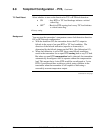
SMV 3000 Transmitter User’s Manual 1/9962
6.8 TempConf Configuration - PV3, Continued
Cold Junction
Compensation
If a thermocouple is used for process temperature PV3 input, you must
select if the cold junction (CJ) compensation will be supplied internally by
the transmitter or externally from a user-supplied isothermal block.
Specify source of cold junction temperature compensation.
• Internal
• External - Must also key in value of cold junction
temperature for reference.
Background
Every thermocouple requires a hot junction and a cold junction for
operation. The hot junction is located at the point of process measurement
and the cold junction is located in the transmitter (internal) or at an
external location selected by the user. The transmitter bases its range
measurement on the difference of the two junctions. The internal or
external temperature sensitive resistor compensates for changes in ambient
temperature that would otherwise have the same effect as a change in
process temperature.
If you configure CJ source as external, you must tell the transmitter what
cold junction temperature to reference by typing in the temperature as a
configuration value. For internal cold junction configuration, the
transmitter measures the cold junction temperature internally.
Output Linearization
For process temperature (PV3) input, configure output to represent one of
these characterization selections.
• Linear
d
- Output is in percent of temperature span.
• Unlinearized - Output is in percent of resistance span for
RTD or millivolts or volts span for T/C.
d
Factory setting.
Background
You can have the transmitter provide a linear output which is linearized to
temperature for PV3 input, or a nonlinear output which is proportional to
resistance for an RTD input, or millivolt or volt input for T/C input. Also,
if you do switch from linear to unlinearized or vice versa, be sure you
verify the LRV and URV settings after you enter the configuration data.
Continued on next page


















